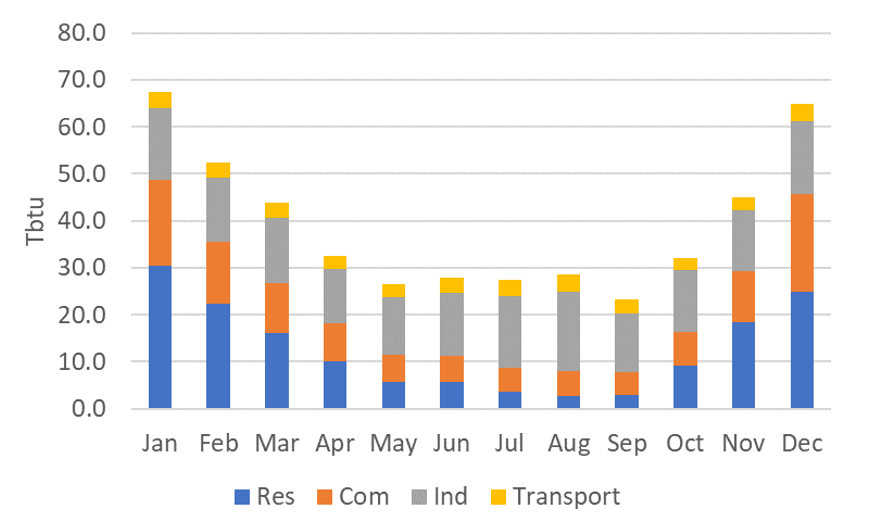The 2021 Power Plan is the first to include a forecast of end-use natural gas consumption. End-use consumption refers to the gas used directly in homes, businesses, industrial processes, and busses and vehicles.
A forecast of all gas use (end-use and power generation) is necessary to study greenhouse gas emission reduction strategies for the region. Such strategies might include a build-out of renewable power, electrification (moving end-use gas to electricity) and renewable natural gas. Our power planning models (RPM[1], Genesys[2], Aurora[3]) can provide insights into the consumption of gas for power generation. For this power plan, we are using our load forecasting model Energy2020[4] to produce the end-use consumption piece.
The Energy2020 model holds the natural gas end-use load characteristics for each sector. A calibration is made to fit the model calculations to historic annual load data by sector. The forecast of economic drivers, efficiency, and fuel prices is then used to set the forecast period usage based on the historic calibration. For example, the model outputs a value for the monthly consumption of natural gas for:
State → Residential → Single Family → Space Heating
The historic annual consumption data for natural gas that is used for the calibration step is sourced from the State Energy Data System (SEDS) via EIA[5]. The overall regional gas usage forecast was checked against other regional gas forecasts, such as the Northwest Gas Association[6], and was also discussed in the Council’s Natural Gas Advisory Committee.
End-use Forecast Results
The forecast is showing slight growth in the end-use of natural gas through the planning horizon; roughly 0.5% per year on average.
The consumption by sector breaks down to:
- Residential 34%
- Commercial 27%
- Industrial 32%
- Transportation 7%
End-use consumption breakdown by state:
- Idaho 18%
- Montana 6%
- Oregon 28%
- Washington 48%
Overall end-use consumption tends to be seasonal with peaks in the winter months and lulls in the summer. Industrial usage is flat throughout the months of the year. Residential use is highly seasonal; roughly 75% of the residential usage occurs in the months of November through March.
The table below summarizes the natural gas forecast by sector and state, and gas source.
Annual Natural Gas Consumption Forecast
| Units TBtu | 2020 | 2025 | 2030 | 2035 | 2040 | 2045 |
| Total Gas | 478 | 476 | 460 | 508 | 510 | 533 |
| Fossil Gas | 478 | 473 | 451 | 487 | 479 | 492 |
| Renewable Natural Gas | 0 | 2 | 9 | 21 | 31 | 41 |
| Residential | 159 | 158 | 142 | 179 | 176 | 190 |
| Commercial | 119 | 122 | 126 | 141 | 148 | 160 |
| Industrial | 163 | 158 | 155 | 152 | 150 | 148 |
| Transportation | 37 | 37 | 37 | 36 | 36 | 35 |
| ID | 85 | 87 | 86 | 93 | 93 | 99 |
| MT | 31 | 29 | 27 | 28 | 28 | 29 |
| OR | 133 | 132 | 127 | 144 | 144 | 151 |
| WA | 229 | 228 | 220 | 243 | 245 | 254 |
Forecast of Natural Gas Use by Month in 2021

End-use related Emissions
Emissions are reported for the forecast of end-use gas. There are two primary greenhouse gases related to the combustion of natural gas – carbon dioxide (CO2), and methane (CH4). Direct emissions refer primary to the CO2 emissions released at the point of use. Upstream methane emission occur as methane is leaked to the atmosphere as fossil natural gas is extracted and transported to the point of use. The table below summarizes the forecast of emissions related to the end-use of natural gas. See the section Upstream Methane Emissions for discussion of upstream methane.
Forecast of End-use Natural Gas Emissions
| Units Million Metric Tons of CO2e | 2020 | 2025 | 2030 | 2035 | 2040 | 2045 |
| Fossil Gas Total | 29.2 | 28.9 | 26.9 | 28.6 | 27.8 | 28.3 |
| Fossil Gas Direct | 25.2 | 25.0 | 23.8 | 25.7 | 25.3 | 26.0 |
| Fossil Gas Upstream | 4.0 | 3.9 | 3.0 | 2.9 | 2.5 | 2.3 |
| Residential Total | 9.8 | 9.6 | 8.3 | 10.1 | 9.6 | 10.0 |
| Commercial Total | 7.3 | 7.4 | 7.4 | 7.9 | 8.1 | 8.6 |
| Industrial Total | 9.9 | 9.6 | 9.0 | 8.5 | 8.1 | 7.8 |
| Transportation Total | 2.3 | 2.3 | 2.1 | 2.0 | 2.0 | 1.9 |
| ID | 5.2 | 5.2 | 5.0 | 5.4 | 5.2 | 5.5 |
| MT | 1.9 | 1.8 | 1.6 | 1.7 | 1.6 | 1.6 |
| OR | 8.1 | 8.0 | 7.4 | 8.0 | 7.7 | 7.9 |
| WA | 14.0 | 13.9 | 12.8 | 13.6 | 13.2 | 13.3 |
[1] https://www.nwcouncil.org/regional-portfolio-model
[2] https://www.nwcouncil.org/energy/energy-advisory-committees/system-analysis-advisory-committee/genesys--generation-evaluation-system-model
[3] https://energyexemplar.com/products/aurora-electric-modeling-forecasting-software
[4] https://www.energy2020.com/energy-2020



